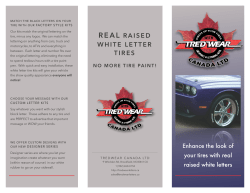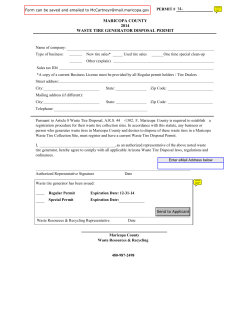
TOP PRIORITY: TIRE SAFETY
TOP PRIORITY: TIRE SAFETY Fatal rollovers of 15-passenger vans are most likely to involve tire failures. NHTSA research shows that tires on 15-passenger vans are often under inflated and in use past their service life. Aged tires are more prone to failure even if they appear to be new (as in the case of original spare tires). Owners and drivers of these vans need to be especially diligent in maintaining correct tire pressure and must be aware that tires deteriorate over time regardless of use. Some vehicle manufacturers recommend that tires be replaced every six years regardless of tread depth. In addition, a number of tire manufacturers cite 10 years as the maximum service life for these tires. Check the owner’s manual for specific recommendations for your vehicle. In order to determine tire age, check the DOT date code located on the inboard sidewall of the tire. The DOT code will be featured at the end of the grouping of characters which begin with the letters “DOT” and end with either three or four digits. If three digits, the tire was manufactured prior to 2000. For example, if the three digit number is “168,” the tire was manufactured in the 16th week of 1998—the last digit refers to the year manufactured and the first two digits refer to the week in that year. If four digits, the tire was manufactured in 2000 or later. For example, “2303” would be the 23rd week of 2003. Safercar.gov | 1-888-327-4236 ADDITIONAL INFORMATION Federal regulations do not prohibit the use of vans by schools, but require any van (with a capacity of more than 10) sold or leased for use as a school bus to meet the safety standards applicable to school buses. Federal regulations apply only to the manufacture and sale/lease of new vehicles. Each State prescribes its own regulations that apply to the use of any vehicle that is used to transport students. Please note the Federal Motor Carrier Safety Administration has special requirements for commercial operators of 15-passenger vans. NATIONAL HIGHWAY TRAFFIC SAFETY ADMINISTRATION 1200 New Jersey Avenue SE. | West Building | Washington, DC 20590 Toll-Free: 1-888-327-4236 | Hearing Impaired (TTY): 1-800-424-9153 9180-051313-v2a 15-PASSENGER VAN SAFETY SAFETY BASICS 15-passenger vans are not like smaller passenger vans and minivans and have a higher rate of rollover under certain conditions. Because of these increased risks, drivers and passengers need to pay greater attention to tire maintenance and road conditions. In addition, driver experience is essential to safely operating these vehicles. It is critical that both drivers and passengers follow some simple safety rules to minimize risks to themselves and their loved ones. National Highway Traffic Safety Administration (NHTSA) data show a significant increase in rollover risk when the van is fully loaded with drivers and passengers. NHTSA has taken steps to reduce this risk by requiring electronic stability control (ESC) systems on all new 15-passenger vans. ESC systems assist drivers in maintaining control of their vehicles even during extreme steering maneuvers or on slippery roads. The presence of ESC may prevent rollovers from occurring, however, 15-passenger vans are often in use for many years, and models produced prior to 2004 likely do not have this crash prevention technology installed. NHTSA’S TOP SAFETY RECOMMENDATIONS FOR 15-PASSENGER VAN USE SIZE TIRE PRESSURE Drive at a safe speed based on driving conditions. Driver should never exceed the posted speed limit. Always slow down if the roads are wet or icy because 15-passenger vans do not respond well to abrupt steering maneuvers and require additional braking time. Inspect the tires and check tire pressure before each use. A van’s tires need to be properly inflated and the tread should not be worn down. Excessively worn or improperly inflated tires can lead to a loss of vehicle control and possibly a rollover. Pressure for front and back tires may be different, and pressure is likely higher than that required for car tires. A placard on the driver’s side B-pillar or the owner’s manual lists manufacturer recommended tire size and pressure. SPARES Avoid using old spares when replacing worn tires since all tires, even unused tires, weaken with age. Used 15-passenger vans may come with new looking spare tires that are many years old and could be dangerous. DRIVER 15-passenger vans should only be operated by trained, experienced drivers who operate these vehicles on a regular basis. The driver needs to possess a valid driver’s license for state of residence (a commercial driver’s license is preferred). 15-passenger van drivers need additional training since these vehicles handle differently than passenger cars, especially when fully loaded. A 15-passenger van is substantially longer and wider than a car, and thus requires more space to maneuver. It also requires additional reliance on the side-view mirrors for changing lanes. SPEED OCCUPANCY Never allow more than 15 people to ride in a 15-passenger van. When the van is not full, passengers should sit in seats that are in front of the rear axle. CARGO Cargo should be placed forward of the rear axle and placing any loads on the roof should be avoided. Do not tow anything behind the van. See the vehicle owner’s manual for maximum weight of passengers and cargo and avoid overloading the van. SEAT BELTS All occupants need to wear seat belts at all times. Inspect seat belts regularly and replace any missing, broken or damaged belts and/or buckles. An unrestrained 15-passenger van occupant involved in a single-vehicle crash is approximately three times as likely to be killed as a restrained occupant. ATTENTION Driver should be well-rested and attentive to driving at all times. Cell phone use by the driver while the van is in motion should be prohibited. Driver should also limit conversation with other passengers, and drive time should be limited to eight hours per 24-hour period. Consumers with questions about this brochure or any safety campaign may call NHTSA’s toll-free Vehicle Safety Hotline at 1-888-327-4236 (TTY: 1-800-424-9153) or visit Safercar.gov Safercar.gov | 1-888-327-4236 Safercar.gov | 1-888-327-4236 Safercar.gov | 1-888-327-4236
© Copyright 2025











